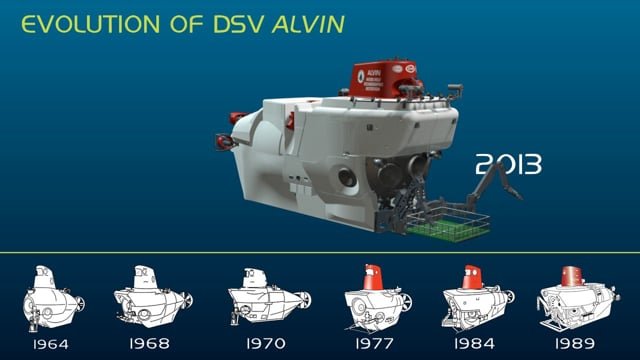
A Quora member posted another interesting question on submarines. The question was “Can you winch a submarine up from the bottom of the ocean, say 8000 feet?” This question gave me the opportunity to write about two famous submarine incidents. One of these involved one of my favorite submersibles ever, the DSV-2 Alvin.
My Answer
Yes it can be done. In fact, I know of two cases where a submarine was winched up from great depths back to the surface.
The first was when the CIA hired Howard Hughes to built a very special ship, the Glomar Explorer, intended to salvage the sunken Soviet submarine K-29. This sub sank on March 8, 1968, northwest of the Hawaiian island of Oahu in 16,000 feet of water.
The Glomar Explorer was designed with a grapple claw at the end of a very long cable, designed to grab the entire submarine hull and haul it back to the surface. Accounts of the recovery vary and the full details have never been released. The best public information released shows the claw grabbed the forward half of the wreck of K-129, but as it was raised the claw suffered a critical failure resulting in the forward section breaking into two pieces with the all-important sail area and center section falling back to the ocean floor.
The CIA probably recovered communications equipment and cipher equipment, and the nuclear-tipped torpedo’s the sub carried. They probably did not recover the submarine’s ballistic missiles and engine room with the reactor. The CIA did claim, after details leaked, that they recovered six bodies which were properly buried at sea with full military honors.
The second case was with the research submersible “DSV-2 Alvin.” Alvin is a manned deep-ocean research submersible owned by the United States Navy and operated by the Woods Hole Oceanographic Institution (WHOI) in Woods Hole, Massachusetts. This submersible weighs 17 tons. It allows for two scientists and one pilot to dive for up to nine hours at 4,500 meters (14,800 feet). The Alvin relies on a surface support vessel to be carried to and from it’s dive points.
On October 16, 1968, the Alvin had just surfaced after completing a dive. It was still alongside it’s surface support vessel Lulu, hatch open, when a wave washed over the open hatch, immediately filling the sub’s pressure sphere and sinking her. The Alvin flooded and sank in 4,900 feet of water. The crew escaped without injury. The Lulu crew marked the location of the sunken submersible.
In August 1969, the Aluminaut, an DSV of that era (built out of aluminum instead of steel/titanium as most deep submergence craft are) was able to secure a line and safety slings on Alvin, and wrapped a prefabricated nylon net around its hull, allowing it to be hauled up by the Mizar. Alvin was towed back to Woods Hole, refurbished, and placed back into service.
Among Alvin’s many great discoveries, she located the wreck of the Titanic in 1986.
Quora Answer
Follow-on Information
I was deeply interested in submarines from the age of eight. At Christmas that year, my maternal grandmother gave me a book titled “Tom Swift jr and his Jetmarine.” I was hooked on submarines from that day on. It was this book that led me into reading science fiction (now shortened to “SciFi” or the detestable “SyFy”). Once I ran out of fiction books on submarines and undersea exploration I started reading space adventures because there wasn’t anything else that interested me.
Besides reading science fiction I also read popular works on submarines and spacecraft. Among those were stories about the deep sea exploration submersibles including the Alvin and Aluminaut. I kept up my reading on undersea exploration and submersible designs over the years.

Over the years I built up a nice collection of books on submarines, most of which I lost when I was flooded out during Hurricane Katrina. But with the help of my cousin Roger, an avid book collector and used book dealer, I was able to rebuild a decent submarine book collection. One book that I especially cherish is titled “Water Baby: The Story of Alvin.” This book tells the story of DSV-2 Alvin starting with her design and launch in 1964, up till publication of the book in 1990. My copy was signed by three of the early crewmembers, making this book a special treasure.
The story of her sinking and recovery was covered in great detail in this book, along with the serendipitous discovery that oxygen is lacking at deep depths, allowing preservation of organic objects. The Alvin crew learned this because they still had some sandwiches in the boat when she sank. Ten months later, when Alvin was recovered, those sandwiches were still “fresh.” This got the crew to wondering why, and then science happened.